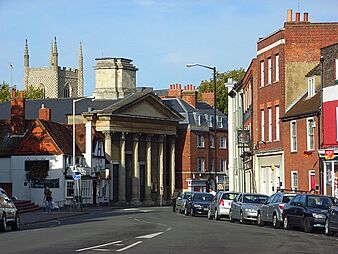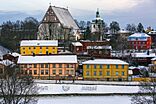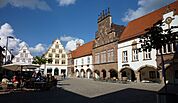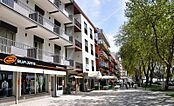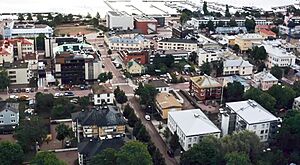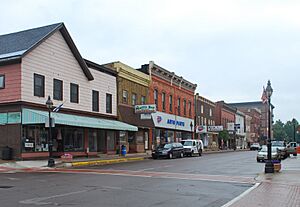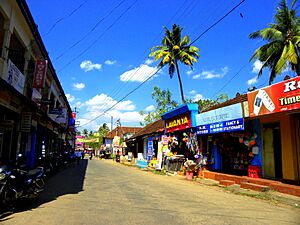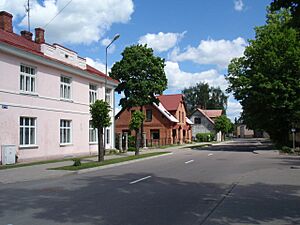Town facts for kids
A town is a type of human settlement. Towns are usually bigger than villages. But they are smaller than cities. How we tell them apart can be different in various parts of the world.
Contents
- How Towns Got Their Names
- What Makes a Town Different?
- A Look Back at Towns
- Towns Around the World
- Australia
- Austria
- Bulgaria
- Canada
- Chile
- Czechia
- Denmark
- Estonia
- Finland
- France
- Germany
- Hong Kong
- Hungary
- Iceland
- India
- Iran
- Ireland
- Israel
- Italy
- Japan
- Korea
- Latvia
- Lithuania
- Netherlands
- New Zealand
- Norway
- Philippines
- Poland
- Portugal
- Romania
- Russia
- Singapore
- South Africa
- Spain
- Sweden
- Ukraine
- United Kingdom
- United States
- Vietnam
- See also
How Towns Got Their Names
The word "town" comes from old words meaning a "fortress" or an "enclosed space." Think of a place surrounded by a fence or a wall. In England, a town was a small community. It might have had a wooden fence (a palisade) instead of big stone walls. In the Netherlands, the word meant a garden, especially a rich person's garden with a high fence. In Norway, it meant a grassy area between farmhouses.
Over time, the meaning changed. In English, "town" started to mean the area inside these fences. Many place names in England still end with "ton" or "toun." This shows where these early settlements were.
What Makes a Town Different?
Sometimes, "town" can be used for a small city or a big village. Today, towns are often different from villages because of their economy. Most people in a town work in factories, shops, or public services. They usually do not work in farming.
The number of people living in a place does not always decide if it is a town. A large village might have more people than a small town. For example, in the United Kingdom, some historic cities are much smaller than bigger towns.
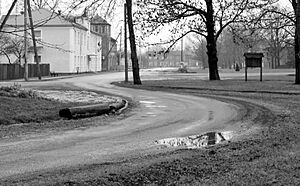
Many towns today have grown into suburbs. People from cities sometimes move to villages. This makes it harder to define what a town is. Some places are like towns in how people live and work, but they don't have all the usual town features.
Towns often have their own local government. They might have their own police. These are called "incorporated towns" in the United States. If a town does not have its own government, it is "unincorporated."
The difference between a town and a city also depends on the rules. A city might be a place that has been officially called a "city" by law. But people also use "city" for a large or important urban area. In the past, a medieval city might have had only 10,000 people. Today, some people think a place needs 100,000 people to be a city. But many official cities are much smaller.
How Towns Grow and Change
A geographer named Thomas Griffith Taylor suggested how towns grow. He saw five types:
- Infantile towns: These are new towns with no clear plan for different areas.
- Juvenile towns: These towns start to have a special area for shops.
- Adolescent towns: Factories begin to appear in these towns.
- Early mature towns: These towns develop a separate area for fancy homes.
- Mature towns: These towns have clear areas for factories, shops, and different types of homes.
A Look Back at Towns
Throughout history, many towns have grown a lot. They developed buildings, cultural centers, and special ways of making money.
Ancient Towns
Çatalhöyük is an archaeological site. It was once thought to be the oldest town where people lived. It existed around 7500 BC. Today, it is a place with old ruins.
Roman Times
In Roman times, a villa was a country settlement. It had a main house and other buildings. It was the center for managing a farm. Later, villas became more like fancy homes. They lost their farming purpose.
There were two types of villas:
- Rustic villas: These were for managing resources. Workers lived there, and farm products were stored.
- Urban villas: These were where the rich owners lived. They looked more like city mansions.
Towns Around the World
How countries define a town is very different. Here are some examples:
Australia
In Australia, most smaller population centers are called towns. Many small towns have fewer than 200 people. Very small ones might be called "townships." Some local governments are also officially called "towns."
Austria
Austria does not have a legal difference between villages, towns, and cities. All are called "municipalities." Larger ones can be called "market towns" or "cities." But this is mostly for tradition. For example, Rattenberg is called a city but has only about 400 people.
Bulgaria
Bulgarians usually don't separate "city" and "town." They use "large towns" for places like Sofia (over 200,000 people). "Small towns" are for places with fewer people. To be called a town, a place needs at least 3,500 people and good services.

Canada
In Canada, each province decides what a town is. For example, in Quebec, there is no legal difference between towns and cities. Both are called ville. In Ontario, municipalities can choose to be called a town, township, city, or village. There is no legal difference between them. Some very large places, like Oakville (over 200,000 people), still call themselves a town.
Chile
In Chile, a town (pueblos) has 2,001 to 5,000 people. Or it can have 1,001 to 2,000 people with a clear economic activity.
Czechia
In Czechia, a place can be a city, town, or market town. This status is given by law. Cities usually have more than 40,000 people. Towns usually have between 1,000 and 35,000 people. To become a town today, a place needs at least 3,000 people.
Denmark
In Denmark, "city," "town," and "village" are often all called by. For small villages, they use landsby ('country town'). For large cities, they use storby ('large town'). Officially, any urban area with at least 200 people is a by.
Estonia
In Estonia, there is no difference between a town and a city. Both are called linn. This word is used for settlements bigger than villages. Estonia has 30 municipal towns.
Finland
Like Estonia, Finland uses one word, kaupunki, for both towns and cities. For smaller towns, they might say pikkukaupunki ('little town'). Finland has over a hundred municipal towns.
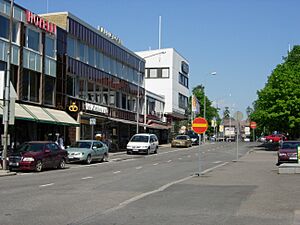
France
In France, all local authorities are called communes. They can have very few or millions of people. The French word for town is bourg, but laws usually don't separate towns and cities. Both are called villes.
Germany
Germans generally use one word, Stadt, for both cities and towns. A village is a Dorf. There are different sizes of Stadt based on population:
- Landstadt ('country town'): under 5,000 people
- Kleinstadt ('small town'): 5,000 to 20,000 people
- Mittelstadt ('middle town'): 20,000 to 100,000 people
- Großstadt ('large town' or 'city'): 100,000 to 1,000,000 people
- Millionenstadt: over 1 million people.
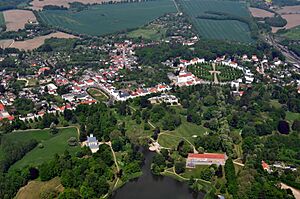
Historically, many places became a Stadt by getting special rights in the Middle Ages. Today, the local government is called a Gemeinde (municipality).
Hong Kong
Hong Kong started building "new towns" in the 1950s. This was to house its growing population. These new towns are planned carefully. They have public housing, shops, and often train lines. Examples include Sha Tin and Tuen Mun.
Hungary
In Hungary, there is no official difference between a city and a town. Both are called város. But people use kisváros ('small town') and nagyváros ('large town') to tell them apart. A village can become a town if it meets certain conditions. These include having public services like a secondary school.
Iceland
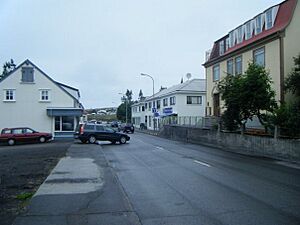
India
The 2011 Census of India defines two types of towns:
- Statutory town: A place with a municipality or other official local government.
- Census town: A place with at least 5,000 people, where most men work in non-farming jobs, and with at least 400 people per square kilometer.
Towns in India usually have basic services like shops, electricity, roads, and schools.
Iran
In modern Persian, there is no difference between "city" and "town." Both are called Shahr. In older texts, Qasabeh was used for a town, but this word is not used much anymore. There are also Shahrak ('small city') for satellite towns and Kuy for neighborhoods.
Ireland
In Ireland, the law defines "towns" based on population. A town can have a "town council." The Central Statistics Office also defines "census towns." A census town is a group of 50 or more homes close together.
Israel
In Modern Hebrew, the word Ayara means 'town'. But it is mostly used for towns in other countries. In Israel, urban areas are almost always called "cities," no matter their size. An exception is a "Development Town" (Ayeret Pituakh). These were built in the 1950s and 60s to be centers for smaller farming communities.
Italy
Italian has words for city (città), town (cittadina or paese), and village (villaggio). But there are no strict legal rules for how to classify them. Both towns and cities are governed as comuni. Generally, a town is bigger than a village but smaller than a city. A city can also be important for its culture or economy.
Japan
In Japan, a "city" (市 shi) usually has over 50,000 people. A "town" (町 machi/chō) and a "village" (村 mura/son) are mainly different by population size when they were founded. Villages usually have under 10,000 people, and towns have 10,000–50,000.
Korea
In both South and North Korea, towns are called eup (읍). Many cities in North Korea are built around a central square.
Latvia
In Latvia, towns and cities are both called pilsēta. This word comes from "castle" and "fence," meaning "what is inside the castle fence." A city can be called lielpilsēta ('big city') or mazpilsēta ('small city/town'). A village is a ciemats.
Lithuania
In Lithuanian, a city is miestas and a town is miestelis ('small miestas').
Netherlands
In the Netherlands, there is no legal difference between "city" and "town." Both are called stad. Historically, about 220 places were given "city rights." Today, a hamlet has fewer than 1,000 people. A village has 1,000 to 25,000 people. A place over 25,000 can be called a village or a city. For example, The Hague never got city rights, but it is a city because of its size (over half a million people).

New Zealand
In New Zealand, a town is a developed area not big enough to be a city. This usually means a population between 1,000 and 20,000. Towns don't have their own legal status. They are part of larger districts or cities.
Norway
In Norway, "city" and "town" are both translated as by. A city can be called storby ('large town'). All are part of a kommune (municipality). The oldest town in Norway is Tønsberg, founded during the Viking Age.
Philippines
In the Philippines, a town is called a municipality (Filipino: bayan). Each municipality has a mayor and a vice mayor. Towns are made up of smaller villages called barangays. Towns have specific rules for their budget, population, and land area to become a town or a city. Cities are usually larger and have a higher political and economic status than towns.
Poland
In Polish, there is no difference between a city and a town. Both are miasto. Cities are the largest municipalities. They are managed by a city mayor (prezydent miasta). Towns are managed by a town mayor (burmistrz). A town might sometimes be called miasteczko, which is a smaller version of the word.
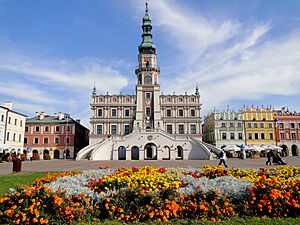
Portugal
In Portugal, there is a traditional difference between towns (vilas) and cities (cidades). A town must have at least 3,000 voters and at least half of certain services (like a health unit, pharmacy, or primary school). Some villages can become towns if they are historically or culturally important.
Romania
In Romania, there is no official difference between a city and a town. Both are called oraş. Larger urban areas can be called oraş municipiu. Smaller ones are just oraş.
Russia
In Russia, the word город (gorod) means both "city" and "town." To be a city or town, a place usually needs more than 12,000 people. Also, at least 85% of the people should work in non-farming jobs.
Singapore
In Singapore, towns are large housing developments. They are designed to have everything people need. This includes homes, shops, and other services. People don't need to leave the town for most things. The most populated town is Bedok.

South Africa
In South Africa, a town is a settlement smaller than a city. The Afrikaans word dorp is used for town.
Spain
In Spain, a town is called villa. It is a place between a village (pueblo) and a city (ciudad). This is not based on population. It is based on historical rights, like the right to hold a market. For example, Madrid is technically a villa, even though it is very large.
Sweden
The Swedish language does not separate towns and cities. Both are called stad. This word has no legal meaning today. An tätort is an urban area. It can be a village with 200 people or a major city. Historically, some municipalities had special "city" charters. But since 1971, all municipalities are called kommun.
Ukraine
In Ukraine, the term town (містечко) existed until 1925. It was then replaced by "urban type settlement." Historically, a Ukrainian town was a smaller place with a market square.
United Kingdom
England and Wales
In England and Wales, a town was traditionally a settlement with a special permission to hold a market or fair. These "market towns" were economic centers for the area. Today, "town" can mean an old market town. Or it can mean a settlement with a "town council."
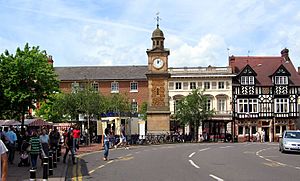
Some places called towns are smaller than large villages. The status of a "city" is only for places that have a special legal document. Historically, cities had a cathedral. But this rule changed. Some large places like Northampton are towns, not cities. Some cities, like Ely, are quite small.
Scotland
In Scotland, the word town has no specific legal meaning. It can mean a group of buildings or any inhabited area. A "Burgh" was the Scottish term for a town or municipality. Burghs were local governments from the 12th century until 1975. They had their own rights and self-governance. Today, the term "burgh" is mostly for historical or ceremonial purposes.
United States
The definition of town in the United States changes a lot from state to state. In some states, a town is an "incorporated municipality." This means it has a special permission from the state. In others, a town is "unincorporated." This means it does not have its own government.
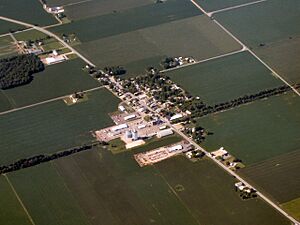
Alabama
In Alabama, a municipality with 2,000 or more people is a city. If it has less than 2,000 people, it is a town.
Arizona
In Arizona, "town" and "city" are mostly the same legally. A community can choose to be a town or a city, no matter its size.
California
In California, "town" and "city" mean the same thing by law. Cities can be "charter" or "general law." Both can call themselves "City of (Name)" or "Town of (Name)."
Illinois
In Illinois, "town" can mean a part of a county called a township. Or it can mean a type of municipality like a village. Some towns are legally incorporated as villages or cities.
Indiana
In Indiana, a town cannot become a city until it has at least 2,000 people. The town council acts as both the lawmakers and the leaders.
Louisiana
In Louisiana, a town is a municipal government with 1,001 to 4,999 people.
Maryland
In Maryland, "town" and "city" are legally the same. The only exception is Baltimore, which is a special "independent city."
Nevada
In Nevada, a town has a government but is not "incorporated." It offers limited services, like planning. Most services are left to the county. Some towns, like Paradise, are very large.
New England
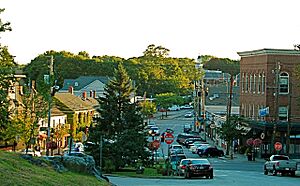
In the six New England states, a town is a very important local government. Towns do many things that counties do in other states. The main difference between a town and a city here is how they are governed. Towns use a "town meeting" and a "board of selectmen." Cities are run by a mayor and a city council.
New Jersey
In New Jersey, a "town" is one type of local government. The Town Act of 1895 allowed any place with over 5,000 people to become a town. The mayor leads the town council and the government.
New York
In New York, a town is a part of a county. It has local powers but fewer than towns in New England. A town provides most services to unincorporated communities called "hamlets." It also provides some services to "villages," which are incorporated. Everyone in New York who does not live in a city or Native American reservation lives in a town.
North Carolina
In North Carolina, all cities, towns, and villages are incorporated. There is no legal difference between them. It is just a choice of the local government. Some North Carolina cities have only 1,000 people. Some towns, like Cary, have over 100,000 people.
Oklahoma
In Oklahoma, a "city" is a municipality incorporated as a city. A "town" is a municipality incorporated as a town. Any community can become a town. If it has 1,000 or more people, it can become a city.
Pennsylvania
In Pennsylvania, incorporated areas are townships, boroughs, and cities. Boroughs are like towns. Only one borough, Bloomsburg, is officially called a "town."
Texas
In Texas, some municipalities call themselves "towns" or "villages." But legally, all incorporated places are considered "cities."
Utah
In Utah, a municipality with 1,000 or more people is a city. If it has less than 1,000 people, it is a town. Cities are also divided into five classes based on population.
Virginia
In Virginia, a town is an incorporated municipality like a city. But towns are located within counties, while cities are independent of counties.
Washington
In Washington, a town is a municipality with fewer than 1,500 people when it is formed. Towns have less government power than cities. Most municipalities in Washington are cities.
Wisconsin
Wisconsin has towns that are areas outside of incorporated cities and villages. These towns keep the name of the civil township they came from. Some towns, especially near cities, have services like police departments.
Wyoming
A Wyoming law says towns are incorporated municipalities with fewer than 4,000 people. Places with 4,000 or more people are "first-class cities."
Vietnam
In Vietnam, a district-level town (Vietnamese: thị xã) is a subdivision below a province. A commune-level town (Vietnamese: thị trấn) is a smaller subdivision below a district.
See also
 In Spanish: Villa (población) para niños
In Spanish: Villa (población) para niños


